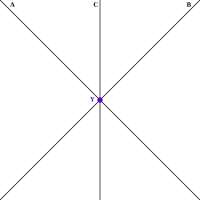Concurrent lines

Imagine you are drawing on a piece of paper with your crayons. You draw one line with your red crayon and another line with your blue crayon. These two lines are called "concurrent lines" because they meet or cross at the same point.
Now let’s pretend that you have lots and lots of crayons, and you want to draw lots and lots of lines on your paper. Some of these lines may be straight, some may be curvy, some may be long, and some may be short. But the important thing is that some of these lines will be concurrent, just like your red and blue lines.
It's like a game of connecting-the-dots: imagine that each dot is the starting point of a line, and all of these lines meet in the same spot. That spot is called the "intersection," and it’s where all the concurrent lines cross each other.
The interesting thing about concurrent lines is that they can be used to find out a lot of cool information. For example, if you draw three lines that are concurrent, they will create three angles. These three angles always add up to be 180 degrees (a full circle). This is called the "angle sum property of triangles."
And with enough clever math and geometry, you can use concurrent lines to figure out all kinds of things about shapes, patterns, and even the world around us!
Now let’s pretend that you have lots and lots of crayons, and you want to draw lots and lots of lines on your paper. Some of these lines may be straight, some may be curvy, some may be long, and some may be short. But the important thing is that some of these lines will be concurrent, just like your red and blue lines.
It's like a game of connecting-the-dots: imagine that each dot is the starting point of a line, and all of these lines meet in the same spot. That spot is called the "intersection," and it’s where all the concurrent lines cross each other.
The interesting thing about concurrent lines is that they can be used to find out a lot of cool information. For example, if you draw three lines that are concurrent, they will create three angles. These three angles always add up to be 180 degrees (a full circle). This is called the "angle sum property of triangles."
And with enough clever math and geometry, you can use concurrent lines to figure out all kinds of things about shapes, patterns, and even the world around us!
